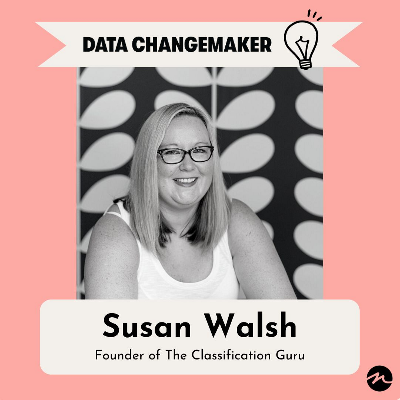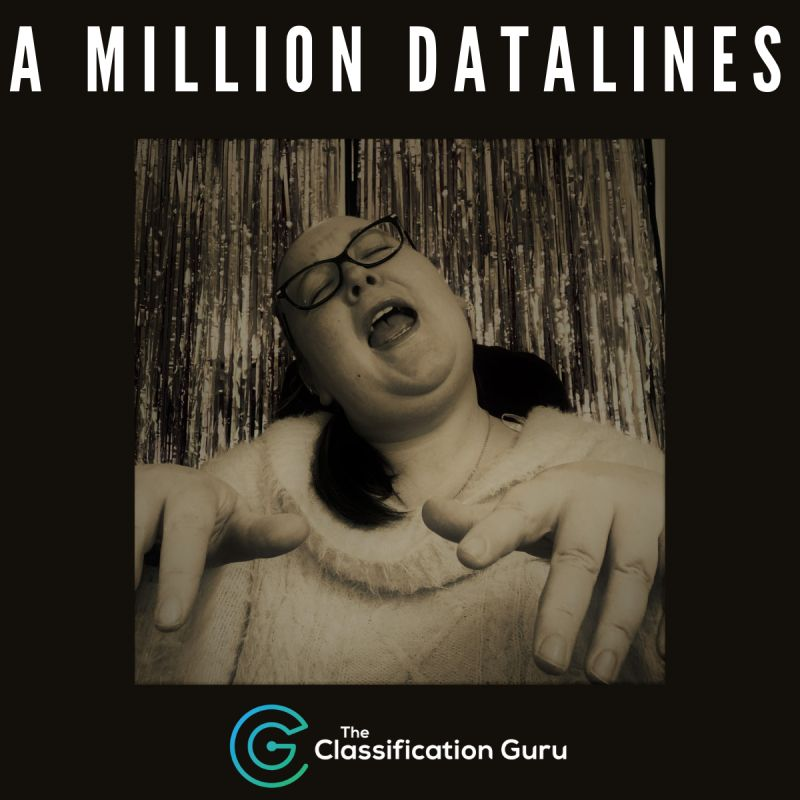How to build and grow a business around data
When times get tough: Susan Walsh shares her ups and downs transparently during her path to success.
I feel the responsibility not to make it seem like I am super successful, with a great, amazing and glamorous life. Some days are great and some days are not so great. I want everyone to see my whole journey.
In case you don’t know her, Susan is:
- An entrepreneur and a business person (Founder of The Classification Guru Ltd).
- A British Data Awards finalist.
- An almost published author — Between the Spreadsheets: Classifying and Fixing Dirty Data.
- A speaker (Check out her speech on the data journey).
- A ProcWomen co-host.
- A fixer of dirty data.
- A lip sync queen (check out #lipsyncsunday — the best way to get past the Monday blues).
Follow us as we go behind the scenes. Susan opens up about her business and her new book!
Huifang: You once had a fashion boutique. What makes you start “The Classification Guru”, which is totally different?
Susan: After the boutique, I was desperate for a job. I found an advertisement online for a job with a spend analytics company and that’s when I started my journey to classifying spend data for the next five years. I was managing a team until I got to a point where I felt I had gone as far as I could.
I didn’t know where I could get a job doing the same thing since I hadn’t worked in a procurement background before. So I decided to start my own business despite having no connections in the industry at all, offering a service that nobody has ever offered before.

Huifang: I have been following your annual blog post on things you have learnt in your years of business. Tell us more about how you went about growing your business.
Susan: I learnt quickly that people didn’t tend to look for me because the service I was offering hadn’t existed before. So it took a number of years just to get awareness out there and spread the words. But it’s starting to pay off now.
In the first 3 years, my blogs are all about trying to stay in business. This year, it will be about how they don’t tell you how hard it is to grow a business.
Just because I’m making money now doesn’t mean all my problems stop. I now have a team of copywriters and assistants to pay. But a project lasting a month or more gets invoiced only at the end and it’s another 30–60 days before I get paid. So sometimes it’s like three months before the money starts coming in.
Also, there’s the challenge of getting the right people to work with. You need to accept that nobody’s going to be as committed as you are because no-one will ever love your business as much as you do.
For me now, it’s about spreading the message to get more people to clean their data. It’s not necessarily about using my service.
Huifang: How do you keep going despite all the problems and frustrations?
Susan: I love what I do! In all the years I have been running this business, I have never had two projects that are the same. Data is unique to each client, so there’s always a new challenge to classify new data that I’ve never classified before.
Having the right coach helped to change my thinking. Vicki Connor helped improve my thinking by changing my negative language.
When I say “I’m going to try to do this”, Vicki will say “No, you’re not going to try anything. You’re going to do something.”
Little things like that change your habits and subconsciously it makes a big difference in how you feel about yourself. Compared to a couple of years ago, my confidence changed from “No one thinks my services are any good” to “I’m awesome”!
It’s fine that not everybody needs my service, I don’t win every project and there are some people I don’t want to work with.
LinkedIn has become really useful because people already know what I am like before they start working with me. They can see my personality on LinkedIn. They know it’s going to be fun working with me. Serious work doesn’t all have to be serious. There will be lots of laughs and work will get done.
Huifang: You wear many hats as a fixer of dirty data: public speaker, lip-sync queen and managing a team on top of that. How do you balance all of this work?
Susan: I have been working hands-on but I’m working to be more hands-off. After spending three years having to do everything because I can’t afford to pay people to do anything else, I can’t just switch like that.
I have to learn to let go and trust people. Even though it is quicker if I do a certain task, my team won’t learn if I don’t let them fail. I’m now more open to letting them take a longer time to get things done, try and experiment and let them fail. Someone trusted me to do that before and that’s how I learnt.
Huifang: What makes you want to write a book?
Susan: I never had the ambition to write a book but I could see that there’s nothing in the market that talks about the kind of work I do. You may learn the most amazing skills at university on how to code and build machine learning models or AI, but nobody tells you to clean data first.
I created a niche that was originally part of someone else’s job. In that sense, I own this data classification space. It also just so happens that the wider data world loves it too!
I didn’t want someone else to come along and do a bad job. So I claimed my own little corner as the expert and I’m going to defend it by setting the standard right.
I’m giving away my trade secrets in the book because I want people to take data quality more seriously. I rather everybody do a little good data quality practice than engage my services.
It doesn’t matter if you have ever worked with data. Whether you are a data analyst, scientist or decision maker within a business, there’s something in there for everybody. I’ve also managed to put in some laughs to make it an enjoyable read.
Huifang: Your book is named “Between the Spreadsheets: Classifying and Fixing Dirty Data” which implies Excel. Are you using Excel to perform your tasks?
Susan: I definitely wouldn’t choose to use Excel myself. But the book is about making this available to the masses and making it less intimidating. Everybody knows Excel and it’s budget-friendly. So most of the book is based on how to fix dirty data and perform data classification using Excel.
There’s a chapter called other methodologies which cover the tool that I work with, called Omniscope. The book shows the difference in time and steps that it takes to do things in Excel versus Omniscope.
Hopefully, we will get to see Susan’s new book by the end of summer. In the meantime, I’m going to stick to my favourite #lipsyncsunday from the lip-sync queen.
If you haven’t read part one of the interview, follow us to discover the latest niche with Susan by COATing dirty data.





